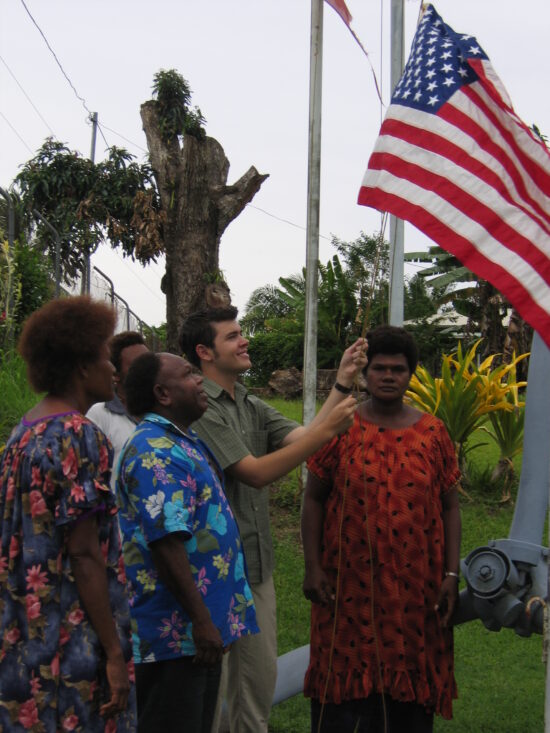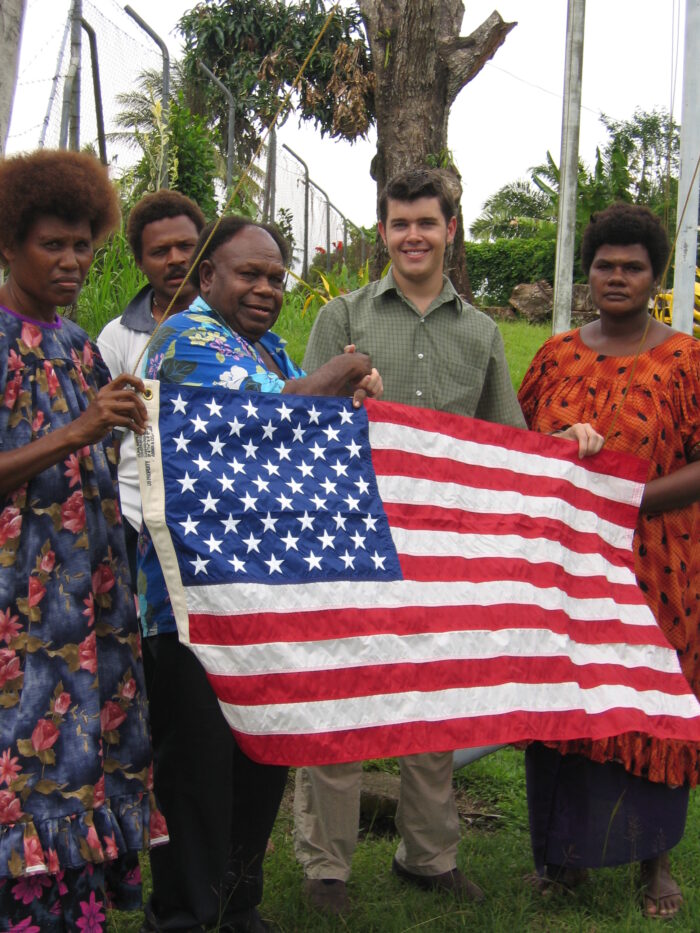By Eric Catalfamo, U.S. Foreign Service Officer and Global Ties U.S. Diplomat-in-Residence
How can we measure the impact of international exchanges? After more than 20 years working in the field of public diplomacy as a U.S. Foreign Service Officer, I still recall an experience from my first overseas assignment whenever this question comes to mind.
I was assigned to the U.S. Embassy in Port Moresby, Papua New Guinea, where our small team oversaw our diplomatic relations with this island nation the size of California, as well as with the neighboring countries of Solomon Islands and Vanuatu. In addition to serving as the sole officer responsible for economic and political matters for three countries, I was asked to restart the post’s public diplomacy operations after several years in which outreach and exchanges had taken a backseat to other priorities.

The author raises the U.S. flag together with the museum director (in blue shirt) and staff. Photos provided by author
There was hardly a day that something interesting didn’t come across my desk, and there were usually more tasks and opportunities than time or staff available to dedicate to them. So, I had to think twice when I received a letter from the director of a history museum in Rabaul, a city on one of Papua New Guinea’s outer islands, asking if the embassy could send him a U.S. flag to display outside of his museum. Did we have a spare flag to send? If we said yes to this request, would we need to say yes to others?
Then I read further in the museum director’s letter and saw that he had traveled to the United States several years earlier as an exchange participant in the International Visitor Leadership Program (IVLP). He said it was this U.S. connection that made him want to display our flag, as a symbol of friendship and cooperation. Since part of my job was to revitalize our people-to-people relationship, I called the museum director to propose I do one better than mail him a flag – I offered to deliver in it person, taking advantage of a stopover that I would have in Rabaul on the way to observe local elections on a nearby island just a few weeks away.
Our IVLP alumni was delighted. When the travel date arrived, I carefully packed the flag and boarded the flight to Rabaul. Flying over tropical jungles and remote fishing villages, I got a sense of just how far I was heading from the capital, not to mention the United States. But arriving at the museum to the director’s warm smile and hearty handshake, we had an instant rapport made possible by the cultural and professional connection forged between Papua New Guinea and the United States through his IVLP visit years earlier.
As we toured the museum, he spoke about the impact of his IVLP experience: how it brought him new contacts and different perspectives on museum management, how he shared his experience within his own networks once back home, and his fond memories of meeting counterparts in a diverse set of cities across the United States. We bonded over his affection for Pittsburgh, my grandmother’s hometown, and discussed ways the embassy could connect him with other exchange program alumni as we sought to develop an alumni association to further deepen the individual and collective impact of our exchanges.
At the end of the visit, the director brought me outside to the line of flagpoles in front of the museum and, together with museum staff, we ceremonially raised the Stars and Stripes over Rabaul’s history museum. We were half a world away from the United States and the Global Ties Network’s Community-Based Members that left a lasting impression on this IVLP alumni, but the closeness of the bonds that were formed through the IVLP couldn’t have been more apparent.

The author (center) and museum director shake hands before raising the U.S. flag.
I had only a few hours in Rabaul, but the experience of meeting an IVLP alumni whose ties to the United States remained strong despite the passage of time and thousands of miles of physical distance gave me a better appreciation of the importance of international exchanges. Spanning the vast ocean between Papua New Guinea and the United States, these truly were global ties, forged by people-to-people citizen diplomacy, that deepened mutual understanding and strengthened our bilateral relationship.
The simple act of re-connecting with an exchange alumni was an eye-opener for me as a new Foreign Service Officer, and it inspired me to do all I could to promote exchanges in that first assignment and the 20 years since. Whether leading the Western Hemisphere’s largest IVLP program in Venezuela or developing innovative youth leadership exchanges for Bosnia and Herzegovina in coordination with Global Ties Network members, I have often thought about my friend in Rabaul as a vivid reminder of the power of exchange programs to promote understanding and bring people together.
Measuring the impact of exchange can be more of an art than a science. Opinions evolve, professional networks grow and adapt, and the positive ripple effect of a single exchange experience can multiply exponentially over time. There’s really no limit to the impact international exchanges can make, but they all begin with the essential “last three feet” of diplomacy – the human connection that is the cornerstone of building and maintaining our global network of people-to-people ties.
